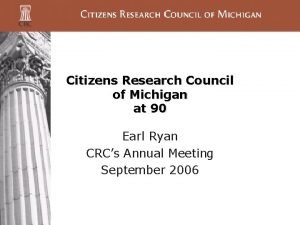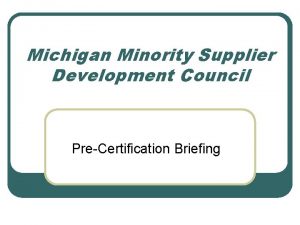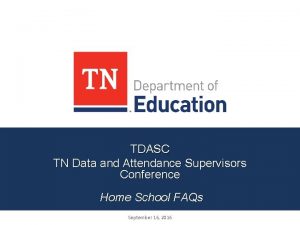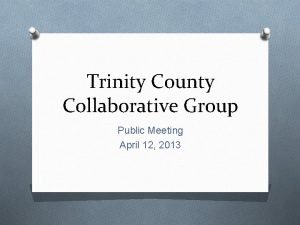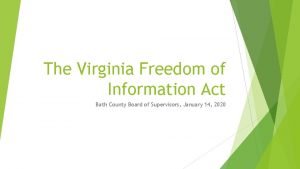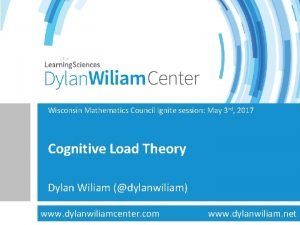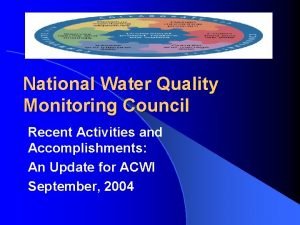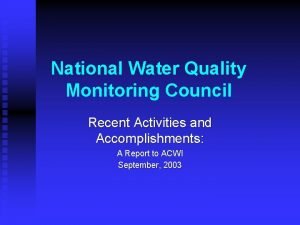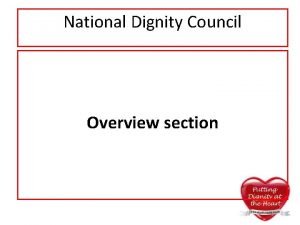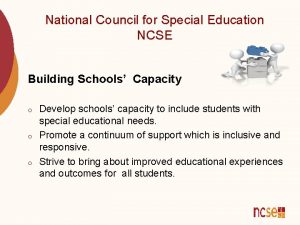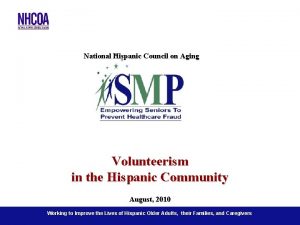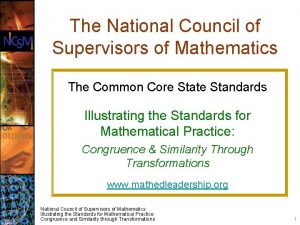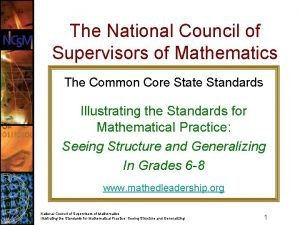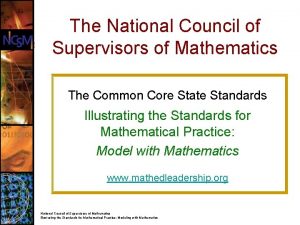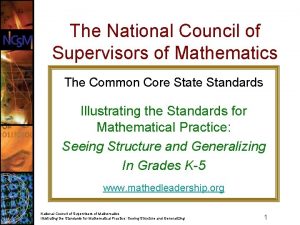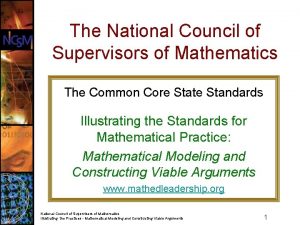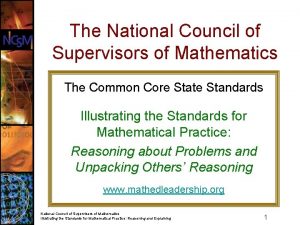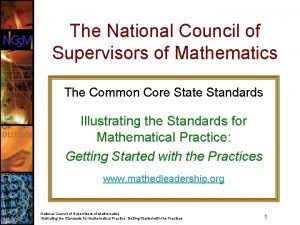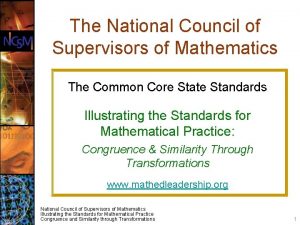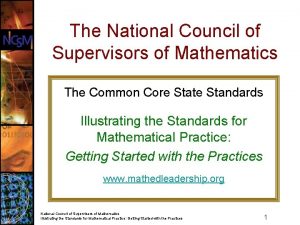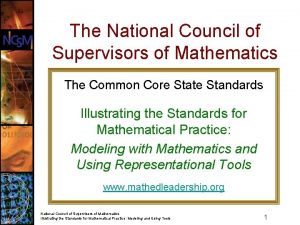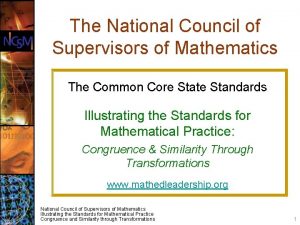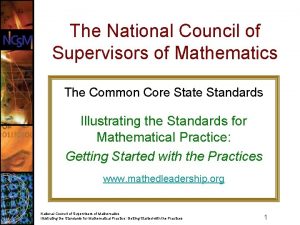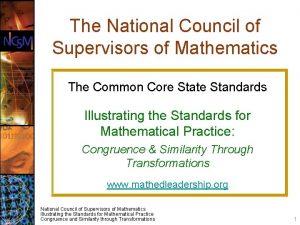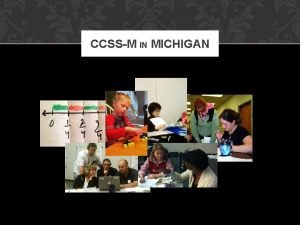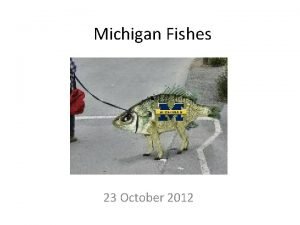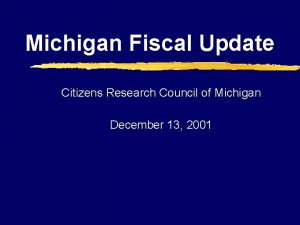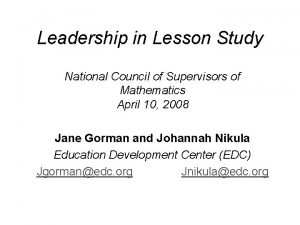National Council of Supervisors of Mathematics Michigan Mathematics



























- Slides: 27

National Council of Supervisors of Mathematics Michigan Mathematics Coordinators and Consultants NCSM Update October, 2011 Ingham ISD Valerie. Mills@oakland. k 12. mi. us

CCSS Resources From NCSM www. mathedleadership. org ü Illustrating the Standards for Mathematical Practices ü CCSS Curriculum Analysis Toolkit 2

CCSS Resources From NCSM www. mathedleadership. org ü Illustrating the Standards for Mathematical Practices ü CCSS Curriculum Analysis Toolkit 3

Illustrating the Standards for Mathematical Practice

NCSM Resources: PD Session titles refer to ready to use professional development module. The modules support the exploration of two or more of the CCSS Mathematical Practices. The sessions are: – – – designed to help teachers deepen their understanding of the practices and implement them in their classrooms situated in classroom practice, anchored by a high demand mathematics task, presented in power point format with slide annotations on the Notes pages to support facilitation 1. 5 to 3 hours in length, designed to be used individually or in combination National Council of Supervisors of Mathematics CCSS Standards of Slide 5

Professional Development Design Each module/session: – Focuses on two or more of the practices – Provides an exploration to guide deeper understanding of the practices – Includes opportunities to support the transfer of new ideas into classroom practice National Council of Supervisors of Mathematics CCSS Standards of Slide 6

www. Inside. Mathematics. org Inside mathematics has resources for: – Classroom Teachers – Mathematics Coaches – School Principals Including: ü Mathematics Tasks & Lessons ü Classroom Video ü Sample Student Work ü Rubrics ü Teacher Reflections and ü More….

Currently Available from NCSM www. mathedleadership. org Illustrating the Standards for Mathematical Practice Modules 1. An Introduction and Overview 2. Reasoning about Problems and Unpacking Others’ Reasoning 3. Mathematical Modeling and Constructing Viable Arguments National Council of Supervisors of Mathematics CCSS Standards of Slide 8

CCSS Resources From NCSM www. mathedleadership. org ü Illustrating the Standards for Mathematical Practices ü CCSS Curriculum Analysis Toolkit 9

Textbook Section Question: How do you pick a textbook when everything … including the latest version of Mc. Guffey’s Reader (1836), promises to be aligned to the Common Core? Answer: Ignore the stickers and use the CCSSO Mathematics Curriculum Analysis Toolkit!

CCSSO Mathematics Curriculum Analysis Toolkit The toolkit includes: • A professional development powerpoint designed to ensure that reviewers are familiar with the three tools to be used in analyzing mathematics curriculum materials • Tool 1—Mathematics Content Alignment • Tool 2—Use of Mathematical Practices • Tool 3—General Overarching Issues

Financial Support for the Curriculum Analysis Toolkit Brookhill Foundation (Kathy Stumpf) Texas Instrument (through CCSSO) In addition to the three alignment tools, the Toolkit includes: Introduction and Overview to the Toolkit Users Guide Suggested Professional Development Agendas

Development Team William S. Bush (chair), Mathematics Educator, University of Louisville, Kentucky Diane Briars, President, National Council of Supervisors of Mathematics, Penn Jere Confrey, Mathematics Educator, North Carolina State University Kathleen Cramer, Mathematics Educator, University of Minnesota Carl Lee, Mathematician, University of Kentucky W. Gary Martin, Mathematics Educator, Auburn University, Alabama Michael Mays, Mathematician, West Virginia University Valerie L. Mills, Supervisor, Mathematics Education, Oakland Schools, MI Fabio Milner, Mathematician, Arizona State University Suzanne Mitchell, Mathematics Educator/Administrator, Executive Director of the Arkansas STEM Coalition Thomas Post, Mathematics Educator, University of Minnesota Robert Ronau, Mathematics Educator, University of Louisville, Kentucky Donna Simpson Leak, Superintendent, Rich Township High School District 227, IL Marilyn Strutchens, Mathematics Educator, Auburn University, Alabama

Development Team William S. Bush (chair), Mathematics Educator, University of Louisville, Kentucky Diane Briars, President, National Council of Supervisors of Mathematics, Penn Jere Confrey, Mathematics Educator, North Carolina State University Kathleen Cramer, Mathematics Educator, University of Minnesota Carl Lee, Mathematician, University of Kentucky W. Gary Martin, Mathematics Educator, Auburn University, Alabama Michael Mays, Mathematician, West Virginia University Valerie L. Mills, Supervisor, Mathematics Education, Oakland Schools, MI Fabio Milner, Mathematician, Arizona State University Suzanne Mitchell, Mathematics Educator/Administrator, Executive Director of the Arkansas STEM Coalition Thomas Post, Mathematics Educator, University of Minnesota Robert Ronau, Mathematics Educator, University of Louisville, Kentucky Donna Simpson Leak, Superintendent, Rich Township High School District 227, IL Marilyn Strutchens, Mathematics Educator, Auburn University, Alabama

Tool Development Process • Development Team formed in October 2010 • First version of tools developed in November 2010 • Initial drafts of tools piloted with groups of elementary middle, and high school teachers in December 2010 • Tools revised based on these pilots • Tools reviewed by postsecondary mathematics educators, mathematicians, and public school administrators nationally in January 2011 • Tools revised based on input from these reviewers to obtain final versions in April 2011

Strategic Decisions • Complete the analysis in grade band groups: K-2, 3 -5, 6 -8, and 9 -12 • Focus on the structure of the CCSS, in particular direct attention toward content “trajectories” of related topics across grade bands (e. g. , addition/subtraction, fractions, solving equations, quadrilaterals) • Recommend analyzing the alignment for only a subset of content standards • Allow ONLY the use of the primary student textbook and the Teachers edition when reviewing the materials

Tool 1: Content Analysis The purpose of Tool 1 is to: • Determine the extent to which the content standards are included in the mathematics textbook materials (Balance of Skills and Concepts) • Determine the extent to which content standards are sequenced appropriately across grade levels in the mathematics textbook materials

Tool 1: K-5 Mathematics Content • Two-Dimensional Geometry for Grades K-2 • Two-Dimensional Geometry for Grades 3 -5 • Place Value and Base 10 Concepts for Grades K-2 • Place Value Concepts for Grades 3 -5 • Addition and Subtraction for Grades K-2 • Multiplication and Division for Grades K-5

Tool 1: 6 -8 Mathematics Content • Ratios and Proportional Relations • Expressions and Equations • Geometry • Statistics and Probability

Tool 1: 9 -12 Mathematics Content • Reasoning with Equations • Interpreting Functions • Similarity and Trigonometry • Interpreting Categorical and Quantitative Data

Tool 2: Mathematical Practices The purpose of tool 2 is to determine the extent to which the mathematics textbook materials reflect and involve students in the Mathematical Practices

Tool 2: Mathematical Practices Look for multiple ways in which the Practices are seen within the textbook materials: • To what extent do the materials demand that students engage in the Standards for Mathematical Practice as the primary vehicle for learning the Content Standards? (Mathematical Practices Content) • To what extent do the materials provide opportunities for students to develop the Standards for Mathematical Practice as “habits of mind” (ways of thinking about mathematics that are rich, challenging, and useful) throughout the development of the Content Standards? (Content Mathematical Practices)

Tool 2: Mathematical Practices Look for multiple ways in which the Practices are seen within the textbook materials: • To what extent do accompanying assessments of student learning (such as homework, observation checklists, portfolio recommendations, extended tasks, tests, and quizzes) provide evidence regarding students’ proficiency with respect to the Standards for Mathematical Practice? • What is the quality of the instructional support for students’ development of the Standards for Mathematical Practice as habits of mind?

Tool 3: Overarching Considerations The purpose of tool three is to consider the ways in which instructional materials treat the overarching issues of – Equity/Diversity/Access, – Formative Assessment, and – Technology The reviewer is encouraged to consider the extent to which these variables support the teaching of Mathematics Core Content and Practices.

Mathematics Assessment Project (MAP) http: //map. mathshell. org. uk/materials/ • 20 ready-to-use Lesson Units for Formative Assessment for high school. cross referenced to CCSS content and practices standards. (Ultimately 20 per grade 7 -12) • Draft summative assessments, aimed at “College- and Career-Readiness, ” presented in two forms: (1) a Task Collection with each task cross-referenced to the CCSS, and (2) a set of Prototype Test Forms showing how the tasks might be assembled into balanced assessments. • Professional development modules are under development 25

Supporting Mathematics Coaches Corner Resources ü on the NCSM website, and ü in the Newsletter and Journal Elementary Mathematics Specialists and Teacher Leader Project (Skip Fennell) : ü http: //www. mathspecialists. org/ üThis Worked!

 Citizens research council of michigan
Citizens research council of michigan Michigan minority supplier development council
Michigan minority supplier development council Tennessee attendance conference
Tennessee attendance conference Eeoc training for managers
Eeoc training for managers Nursing supervisors are selected using random numbers
Nursing supervisors are selected using random numbers Ergonomics awareness training for supervisors
Ergonomics awareness training for supervisors Ergonomics awareness training for supervisors
Ergonomics awareness training for supervisors Eeo compliance training
Eeo compliance training Situational frontline leadership
Situational frontline leadership Danger zones for supervisors
Danger zones for supervisors Trinity county board of supervisors meeting
Trinity county board of supervisors meeting Bath county board of supervisors
Bath county board of supervisors Pa state association of township supervisors
Pa state association of township supervisors Pa state association of township supervisors
Pa state association of township supervisors Gp supervisors australia
Gp supervisors australia Wisconsin math council
Wisconsin math council National council of youth sports
National council of youth sports National water quality monitoring council
National water quality monitoring council National water quality monitoring council
National water quality monitoring council National employment law council
National employment law council National dignity council
National dignity council National council for special education
National council for special education National aids council tenders
National aids council tenders National crime prevention council cyberbullying
National crime prevention council cyberbullying Arts council national lottery project grants
Arts council national lottery project grants National science council taiwan
National science council taiwan Singapore resuscitation and first aid council
Singapore resuscitation and first aid council National hispanic council on aging
National hispanic council on aging
